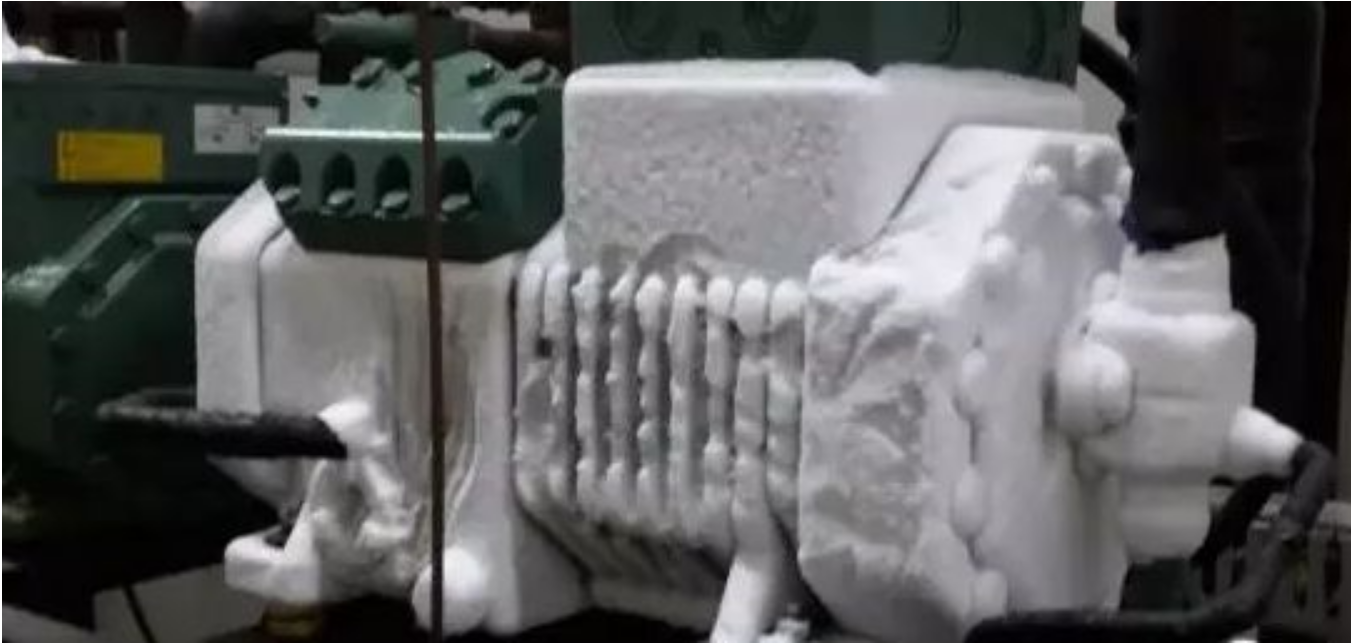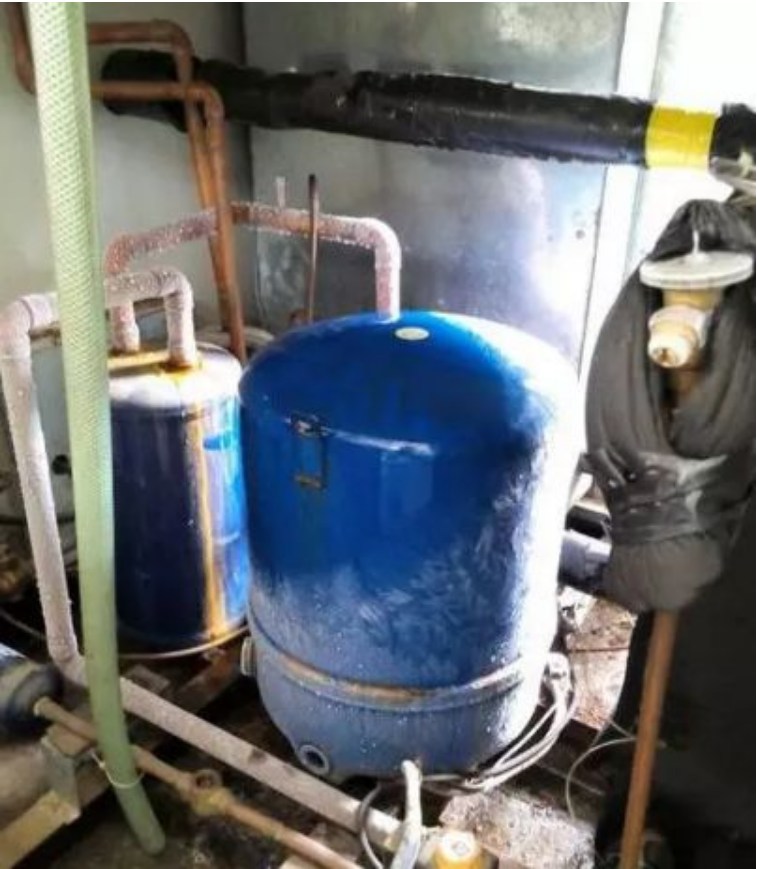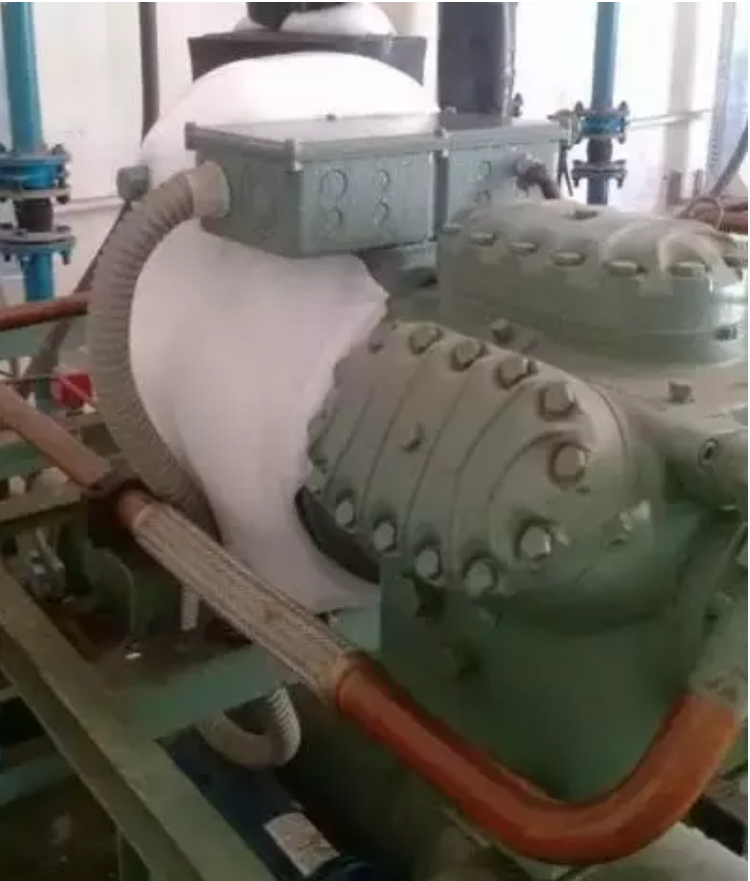The compressor in the factory is frosted! What should I do
It has been really cold in recent days, do the Seven Friends also feel the chill of the approaching New Year? The compressor in the factory works very well! It turned out to be frosted! ! What is going on? What should I do? Quickly follow the editor to have a look!

Frosting on compressor return port
The frost on the compressor return air port indicates that the compressor return air temperature is too low, so what will cause the compressor return air temperature to be too low?
We all know that if the volume and pressure of the refrigerant of the same quality are changed, the temperature will behave differently, that is, if the liquid refrigerant absorbs more heat, then the refrigerant of the same quality will exhibit higher pressure, temperature, and volume. With less heat, the pressure, temperature, and volume will be lower.

That is to say, if the return air temperature of the compressor is low, it will generally show a low return air pressure and a high amount of refrigerant of the same volume. The root cause of this situation is that the refrigerant flowing through the evaporator cannot fully absorb itself and expand to a predetermined pressure. The heat required for the temperature value causes the temperature, pressure and volume of the return air to be relatively low.
There are two causes of this problem:
The liquid refrigerant supply of the throttle valve is normal, but the evaporator cannot absorb heat and supply the refrigerant to expand normally.
The evaporator absorbs heat normally but the throttle valve refrigerant supply is too much, that is, the refrigerant flow is too much. We usually understand that there is too much fluorine, which means that too much fluorine will also cause low pressure.
Less fluorine causes frost on compressor return air
1.Since the flow of the refrigerant is extremely small, it will cause the refrigerant to expand from the first expandable space after it flows out of the rear end of the throttle valve. Most of us see that the frosting of the rear end of the expansion valve is often due to lack of fluorine or the expansion valve. Caused by insufficient flow, too little refrigerant expansion will not use all of the evaporator area, but will only form a low temperature in the evaporator, part of the area due to the small amount of refrigerant and rapid expansion, causing local temperature to be too low, and evaporator frosting .

After partial frosting, due to the formation of a heat insulation layer on the surface of the evaporator and the low heat exchange in this area, the expansion of the refrigerant will transfer to other areas, and frost or icing of the entire evaporator will gradually appear, and the entire evaporator will form heat insulation. As a result, the expansion spreads to the compressor return pipe, causing the compressor return air to frost.
2.Due to the small amount of refrigerant, the low evaporation pressure of the evaporator leads to low evaporation temperature, which will gradually cause condensation in the evaporator to form a heat insulation layer and transfer the expansion point to the compressor return air to cause frosting of the compressor return air. The above two points will show the frosting of the evaporator before the compressor return air is frosted.

In fact, in most cases, for the phenomenon of frosting, you only need to adjust the hot gas bypass valve. The specific method is to open the rear end cover of the hot gas bypass valve, and then use a No. 8 Allen key to turn the inner adjusting nut clockwise. If it is too fast, you will usually pause after a half-turn, let the system run for a period of time, and then decide whether to continue the adjustment after seeing the frosting situation. After the operation is stable and the frosting of the compressor disappears, tighten the end cover.
For models below 15 cubic meters, since there is no hot gas bypass valve, if the frosting phenomenon is serious, you can appropriately increase the take-off pressure of the condensing fan pressure switch. The specific method is to find the pressure switch first, remove the small piece of the pressure switch's adjusting nut, and then rotate it clockwise with a Phillips screwdriver. The entire adjustment needs to be carried out slowly. Adjust a half circle to see the situation before deciding whether to adjust.
Cylinder head is frosted
is always caused by a large amount of wet steam or refrigerant sucked into the compressor (in severe cases, the crankcase is frosted). The main reasons for this situation are:
1. The opening of the thermal expansion valve is adjusted too large, the temperature sensing bulb is installed incorrectly or the fixing is loose, so that the temperature felt is too high and the valve core opens abnormally.
The thermal expansion valve uses the superheat at the outlet of the evaporator as the feedback signal, and compares it with the given superheat value and generates a deviation signal to adjust the refrigerant flow into the evaporator. It is a direct acting proportional regulator. Signal device, regulator and actuator in one.

When the parameters measured by the transmitter deviate from the given value, the physical quantity of the transmitter changes and generates enough energy to directly push the actuator to move. The position change of the actuator is proportional to the adjusted parameter.
Thermal expansion valves can be divided into two types: internally balanced thermal expansion valves and externally balanced thermal expansion valves according to different balancing methods. The liquid refrigerant evaporates and absorbs heat in the evaporator, and when it flows to the evaporator outlet, it has been completely vaporized and has a certain degree of superheat. The temperature sensing tube of the thermal expansion valve is closely attached to the evaporator outlet pipe and feels the temperature of the evaporator outlet. If the liquid filled in the bulb is the same as the refrigerant, the pressure of the liquid above the diaphragm of the thermal expansion valve is greater than the pressure of the liquid below the diaphragm, and the higher the temperature of the evaporator outlet, the greater the degree of superheat, and the The greater the liquid pressure.

This pressure difference is balanced by the tension of the ejector rod and the adjusting spring below the diaphragm. If you change the tension of the adjusting spring, you can change the top force of the ejector rod, thereby changing the opening of the needle valve. Obviously, the degree of superheat of the evaporator will also cause the change of the needle valve opening. When the adjusting spring is adjusted to a certain position, the expansion valve will automatically change the needle valve opening according to the temperature of the evaporator outlet, so that the evaporator outlet superheat is maintained at a certain value.
The opening of the thermal expansion valve is adjusted too large, the temperature sensing bulb is installed incorrectly or the fixing is loose, so that the felt temperature is too high and the valve core opens abnormally, causing a large amount of wet steam to be sucked into the compressor, causing frost on the cylinder head. The thermal expansion valve is used to adjust the superheat degree when the evaporator is working.
If the outlet superheat of the evaporator is too high, the overheating section at the rear of the evaporator is too long, and the cooling capacity will be significantly reduced; if the outlet superheat is too small, it may cause the compressor to hit or even frost the cylinder head. It is generally believed that the expansion valve should be adjusted to the evaporator outlet with a superheat of 3℃~8℃.

2. The liquid supply solenoid valve leaks or the expansion valve is not closed tightly when the machine is shut down, causing a large amount of refrigerant liquid to accumulate in the evaporator before starting. The temperature relay is used in conjunction with the solenoid valve to control the storage temperature.
The temperature sensor of the temperature relay is placed in the cold storage. When the temperature of the cold storage is higher than the upper limit of the set value, the contact of the temperature relay is turned on, the solenoid valve coil is energized, the valve opens, and the refrigerant enters the evaporator to cool down; At the lower limit of its setting value, the temperature relay contact opens, cuts off the solenoid valve coil current, the solenoid valve closes, and the refrigerant stops entering the evaporator, so that the storage temperature can be controlled within the required range.

3. When starting the compressor, the suction stop valve is opened too large or opened too early.
4. When there is too much refrigerant in the system, the liquid level in the condenser is higher, and the condensation heat exchange area is reduced, which increases the condensation pressure, that is, the pressure before the expansion valve increases, and the amount of refrigerant flowing into the evaporator increases. The agent cannot evaporate completely in the evaporator, so the compressor sucks in wet steam, and the cylinder hair is cold or even frosted, which may cause "liquid hammer", and the evaporation pressure will be high.



